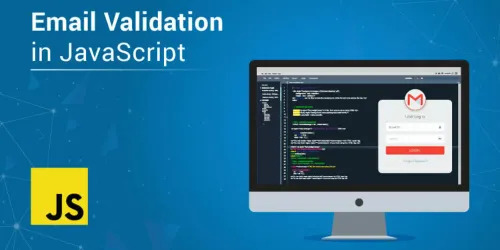Email validation is a critical aspect of web development, ensuring that the data collected from users is accurate and reliable. JavaScript, as a versatile and widely-used programming language, offers robust tools for implementing email validation. In this comprehensive guide, we will explore the intricacies of email validation in JavaScript, including the use of regular expressions. Whether you're a seasoned developer or a beginner, this guide will equip you with the knowledge and sample code needed to perform flawless email validation in your web applications.
Understanding the Importance of Email Validation
Before we delve into the technical details and sample code, it's essential to grasp why email validation is crucial for web applications.
Data Accuracy: Email validation ensures that the data collected from users is accurate and properly formatted, reducing errors and data inconsistencies.
User Experience: It enhances the user experience by preventing users from submitting invalid or mistyped email addresses, which can lead to frustration and errors.
Security: Proper email validation can help protect your application from spam, phishing attempts, and potentially malicious input.
Communication: Valid email addresses are essential for sending notifications, updates, and important information to users.
The Anatomy of Email Validation in JavaScript
Email validation in JavaScript typically involves the use of regular expressions, a powerful tool for pattern matching. A regular expression, often referred to as a regex, is a sequence of characters that defines a search pattern. In the context of email validation, regex allows us to define the pattern for a valid email address.
Here's a breakdown of the common elements in an email address regex pattern:
The Local Part: This includes the username, which can consist of letters, digits, hyphens, and periods. It's followed by the "@" symbol.
The "@" Symbol: This symbol is mandatory in all email addresses and serves as the delimiter between the local part and the domain.
The Domain Name: This includes the domain, which can consist of letters, digits, hyphens, and periods. It's followed by a period and the top-level domain (TLD).
Here's a simplified example of what a regex pattern for email validation in JavaScript might look like:
const emailPattern = /^[a-zA-Z0-9._-]+@[a-zA-Z0-9.-]+\.[a-zA-Z]{2,4}$/;
In this regex pattern:
^[a-zA-Z0-9._-]+: Matches the local part of the email address.@: Matches the "@" symbol.[a-zA-Z0-9.-]+: Matches the domain part of the email address.\.: Matches the period separating the domain and TLD.[a-zA-Z]{2,4}$: Matches the TLD, which should consist of 2 to 4 letters.
Sample JavaScript Code for Email Validation
Now, let's explore sample JavaScript code for email validation using the regex pattern discussed earlier. You can use this code as a foundation for email validation in your web projects.
function validateEmail(email) {
const emailPattern = /^[a-zA-Z0-9._-]+@[a-zA-Z0-9.-]+\.[a-zA-Z]{2,4}$/;
return emailPattern.test(email);
}
// Example usage:
const email = "[email protected]";
if (validateEmail(email)) {
console.log("Valid email address.");
} else {
console.log("Invalid email address.");
}
In this code:
- The
validateEmailfunction takes an email address as input. - It uses the
testmethod of the regex pattern to check if the email address matches the defined pattern. - Depending on the result, the function returns
truefor a valid email address andfalsefor an invalid one.
Common Challenges and Tips
While email validation using regex is powerful, it's not without its challenges. Here are some common issues and tips to address them:
1. Matching All Valid Email Addresses:
- Regex patterns can be complex to match all valid email addresses, including those with special characters. Consider using established email validation libraries or services for comprehensive validation.
2. Internationalization:
- Email addresses can have international characters in the local part and domain. Ensure your regex pattern and validation logic account for internationalization.
3. Server-Side Validation:
- While client-side validation is useful for improving user experience, always perform server-side validation as well to prevent malicious input.
4. Keeping Patterns Up to Date:
- Email standards and TLDs may change over time. Periodically review and update your regex pattern to reflect the latest email address formats.
5. User-Friendly Error Messages:
- Provide clear and user-friendly error messages when email validation fails to guide users in correcting their input.
FAQs about Email Validation in JavaScript
Q1. Is email validation in JavaScript sufficient for security purposes?
A1. Email validation in JavaScript is a valuable step to improve data accuracy and user experience. However, it should be complemented with server-side validation for security.
Q2. Can I use a single regex pattern to match all valid email addresses?
A2. While you can create a regex pattern that covers a broad range of valid email addresses, handling all edge cases can be complex. Consider using established libraries or services for comprehensive validation.
Q3. How can I handle international email addresses in JavaScript?
A3. To handle international email addresses, use regex patterns that allow for international characters in the local part and domain. Additionally, ensure your backend supports internationalization.
Q4. What's the best approach for displaying error messages to users during email validation?
A4. Provide clear and user-friendly error messages that indicate why the email address is invalid (e.g., "Please enter a valid email address"). This helps users understand and correct their input.
Q5. Are there any JavaScript libraries or packages for email validation?
A5. Yes, there are several JavaScript libraries and packages available for email validation, such as validator.js and email-validator. These libraries simplify the validation process and handle a wide range of email address formats.
In conclusion, email validation in JavaScript is a fundamental aspect of web development, ensuring data accuracy and enhancing user experience. By understanding the regex patterns and using the sample code provided in this comprehensive guide, you can implement effective email validation in your web projects. Remember to stay updated with evolving email standards and best practices to maintain the security and reliability of your applications.



